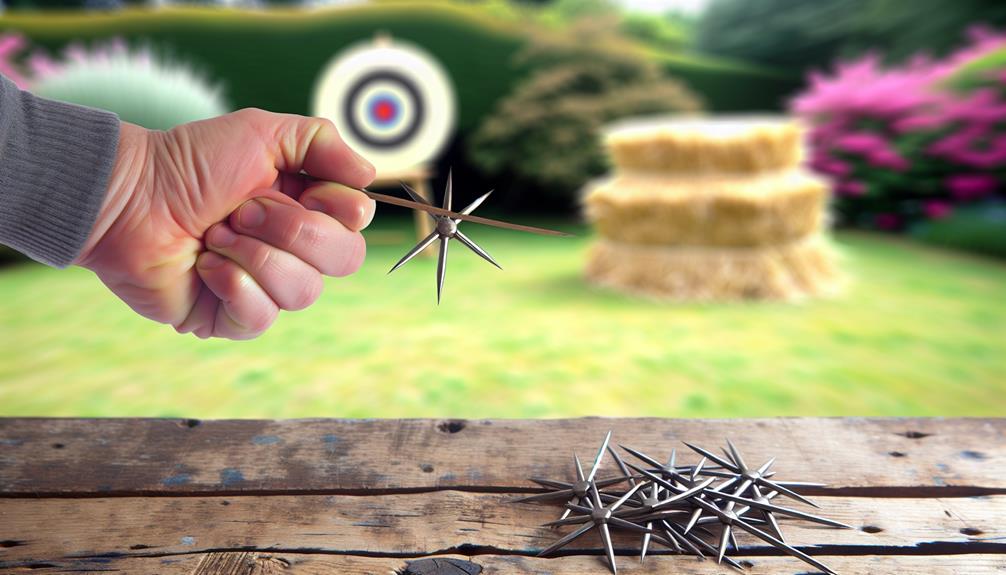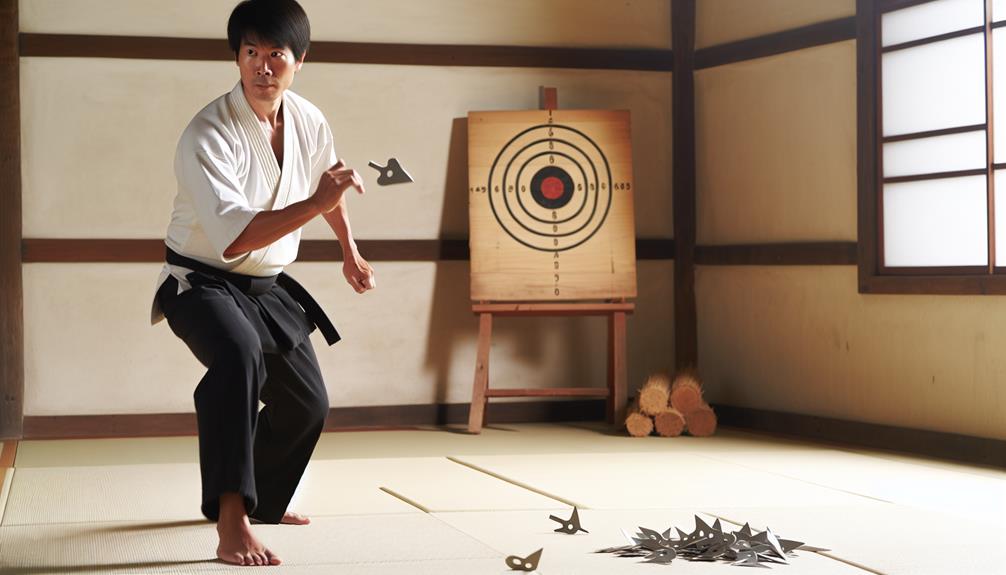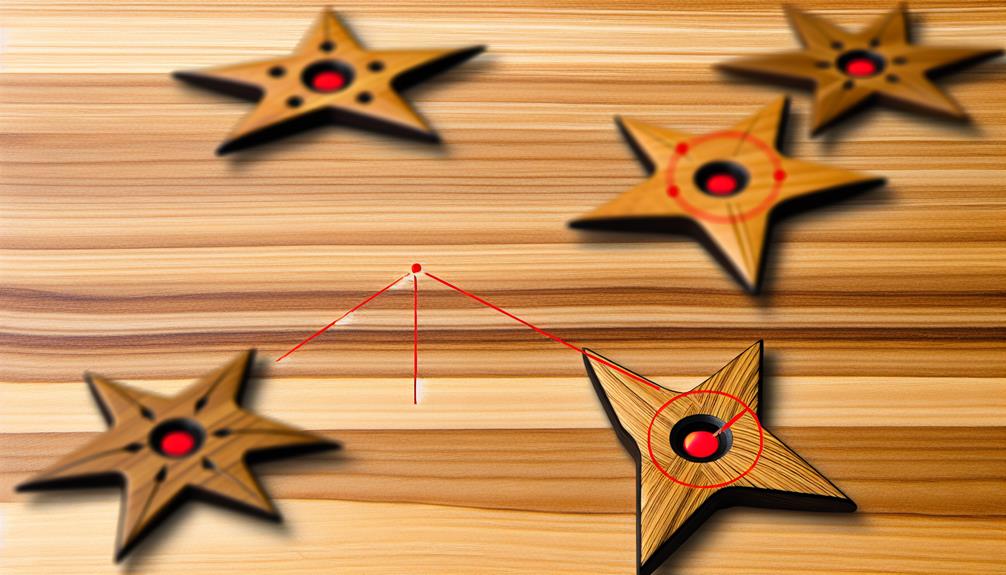
Brainstorm Security Shop

For Orders Over $199

On Any Of Our Products

Details On Refund Page
You’ve likely noticed how a well-balanced throwing star can significantly enhance your precision and control. This stems from meticulous weight distribution, which ensures each point and blade of throwing stars moves in harmony during a throw. But have you considered the subtle differences in design that might influence this balance? Whether it’s the material used or the angle of the points, each element plays a critical role in the star’s performance. Let’s explore how these factors converge to create the perfect throwing star, and why mastering this could elevate your skill to new heights.
Proper weight distribution is crucial when designing throwing stars. If you’re aiming for optimal throwing accuracy, understanding how to balance the weight can significantly enhance your skill.
Throwing stars, or shuriken, demand precise weight balance to ensure they rotate properly and reach their target effectively.
You’ve got to consider that each point or blade of the star needs to be uniformly weighted. This symmetry allows the star to spin smoothly through the air. If one point is heavier, the star will veer off course, making it much harder to hit your target accurately.
Think about it this way: when you throw a star, you rely on its aerodynamics to maintain a straight, predictable trajectory. Any imbalance in weight distribution disrupts this trajectory.
This is why meticulous attention to detail is essential when crafting or choosing a throwing star. Each segment’s weight must be perfectly calibrated against the others for true precision.

Understanding the physics of throwing stars helps you grasp how they achieve their precision. When you throw a star, the way it spins and maintains its course is dictated by principles such as spin dynamics and angular momentum. These aren’t just fancy terms; they’re crucial to ensuring your throwing star doesn’t veer off target.
Spin dynamics refers to how the star rotates around its center as it moves through the air. This rotation is essential because it stabilizes the star, much like a spinning top. Without sufficient spin, the star would tumble haphazardly. You might notice that the faster the spin, the steadier the flight.
Angular momentum is key to understanding why this stabilization occurs. It’s a physical quantity that represents the amount of rotation of an object and its resistance to change in that rotation.
When you throw the star with a twist of your wrist, you’re imparting angular momentum to it. This momentum keeps the star spinning on its axis during flight, ensuring it stays on its intended path and doesn’t wobble.
Different design variations of throwing stars can significantly impact their performance. You’ll find that the weight distribution, size, and number of points play crucial roles. A star with more points might seem advantageous because it increases the likelihood of sticking to a target, but each additional point can also compromise the balance if not crafted precisely.
Consider the aesthetic appeal of these stars. Their designs aren’t just about looking good; they enhance the overall functionality. Intricate patterns and symmetry aren’t just for show; they help maintain the balance and rotation necessary for accurate throws. The cultural significance of each pattern can also influence design choices, imbuing each piece with a backstory that might affect its weight distribution and shape.
Moreover, materials used in throwing stars affect both weight and performance. Heavier metals might provide more momentum, but they require greater skill to throw accurately. Meanwhile, lighter materials might make for easier handling, but they often require a more forceful throw to achieve effective penetration.
Understanding these nuances will help you appreciate how deep the interplay between form, function, and tradition can be in the world of throwing stars.
When choosing the right throwing star, you’ll need to consider both the material used and the design.
Each material offers distinct advantages in terms of weight and durability, affecting your throwing precision and style.
Pay close attention to design considerations; specific features can enhance balance and aerodynamics, crucial for achieving optimal performance.
Choosing the right material for your throwing star is crucial as it directly affects performance and durability. You’ll find that steel types vary widely, each offering different benefits depending on your needs.
Stainless steel, for instance, is highly resistant to corrosion and maintains a sharp edge, making it a favorite for both beginners and seasoned throwers. However, if you’re looking for something with a bit more heft, carbon steel might be your go-to. It’s known for its exceptional durability and ability to retain sharpness, but it requires more maintenance to prevent rust.
When you’re selecting a material, consider the balance factors. The weight distribution of the throwing star impacts its flight and accuracy.
A well-balanced star made from the appropriate steel can achieve a consistent throwing pattern, essential for precision targeting. You don’t want your star too light or too heavy; it should feel just right in your hand, almost as if it’s an extension of your arm.
After selecting the ideal material, your next step is to focus on the design of your throwing star. You’ll want to consider both its aesthetic appeal and functionality to ensure it not only looks great but performs exceptionally as well. The design isn’t just about visual impact; it’s crucial for achieving the perfect balance and precision in flight.
When you’re choosing the right throwing star, think about the shape and size that best fits your throwing style and grip. An ergonomic grip is essential; it makes the star comfortable to hold and easier to throw accurately. The contours of the star should align with your fingers, allowing for a secure yet natural grip. This detail can significantly enhance your control and confidence during each throw.
Additionally, don’t overlook the aesthetic appeal of your throwing star. A well-designed star that looks impressive can boost your morale and intimidate your competitors, whether in a friendly contest or a more serious setting.
Opt for a design that reflects your personality or cultural heritage, adding a personal touch that makes the star uniquely yours.
Mastering the art of throwing stars requires precise techniques and a keen understanding of mechanics. To start, you’ll need to focus on your stance. Position your feet shoulder-width apart, ensuring you’re balanced and grounded. Grip the star between your thumb and forefinger, ensuring the point aligns with your aim.
When it comes to throwing techniques, the overhand throw is fundamental. Draw your arm back, elbow bent, and as you swing forward, release the star at eye level for the most accurate trajectory. Keep your wrist firm throughout the motion to avoid wobbling.
Accuracy drills are crucial in honing your skills. Begin by targeting a large, static object to build confidence. As you improve, reduce the target size and increase the distance.
Consistent practice is key, as repetition builds muscle memory and precision.
Throughout history, throwing stars, or shuriken, have evolved significantly from their origins in feudal Japan. Initially, they were tools for distraction or minor injury during escapes. Over time, their design and usage refined, aligning with the growing needs of stealth and precision. You’d find that each star bore the weight of its cultural significance, not just in martial arts but as a symbol of the covert warrior.
Delving deeper into their ancient origins, you’d see that these weapons weren’t merely instruments of war but held a deeper, almost spiritual significance. They were often used in ceremonies and carried by samurai and ninjas alike, embodying the silent codes and philosophies of these warriors. The craftsmanship was meticulous, reflecting the era’s profound connection to both art and functionality.
As you trace the journey of shuriken through the ages, you’ll notice how their evolution mirrors changes in warfare tactics and societal structures. The balance in their design—a blend of practicality and artistic expression—speaks volumes about the era’s technological advancements and the shifting paradigms in military strategy.
Thus, the shuriken isn’t just a relic; it’s a testament to the ingenuity and spirit of ancient Japan.

To ensure your shuriken remain in top condition, regularly check and maintain them. Start by implementing effective cleaning techniques. After each use, wipe down your shuriken with a soft cloth to remove dirt and residue.
For a deeper clean, use a mild detergent diluted with water, ensuring you thoroughly dry each piece to prevent rust.
It’s crucial to inspect your shuriken for any signs of wear or damage, such as nicks or bent tips. If you spot these issues, address them immediately to avoid affecting your throwing accuracy.
Occasionally, you might need to oil the metal to keep it smooth and resistant to corrosion. Use a light machine oil, applying just enough to coat the surface without leaving it greasy.
Proper storage solutions are also key to prolonging the life of your shuriken. Avoid tossing them into a drawer or box where they can get damaged.
Instead, invest in a dedicated storage case with individual compartments for each shuriken. This prevents them from knocking against each other and maintains their balance and sharpness.
Throwing stars aren’t ideal as your primary self-defense tool due to their limited effectiveness and the skill required in throwing techniques.
They’re difficult to master and not as reliable as other more straightforward self-defense options.
You’re better off considering more accessible and effective tools like pepper spray or a stun gun.
These alternatives ensure you can defend yourself quickly and effectively, without needing the precision and practice throwing stars demand.
Yes, there are competitive sports involving throwing stars. You’d find them fascinating if you appreciate precision and skill.

Competitors focus on mastering throwing techniques to hit targets accurately. To participate, you’ll need to understand the competition rules, which ensure fairness and safety for all participants.
These contests not only test your dexterity but also challenge your ability to remain calm and focused under pressure. Consider giving it a try!
You might wonder about the legality of owning a throwing star. It varies widely by country, heavily influenced by local throwing star regulations and the cultural significance of such weapons.
In some places, you can freely own and use them, often with a focus on martial arts heritage. However, in many countries, they’re strictly prohibited due to perceived dangers and misuse.
Always check local laws before acquiring a throwing star to ensure you’re not breaking any rules.
Different materials significantly alter a throwing star’s flight and impact.
Material density affects the weight distribution, crucial for maintaining a stable flight path. Lighter materials might increase speed but reduce impact force. Conversely, heavier materials ensure deeper penetration but might slow the throw.
Aerodynamic design is also vital; smoother, well-shaped edges help maintain a swift, accurate trajectory.
You’ll find that balancing these factors is key to optimizing performance.
When exploring the ethics of using throwing stars in martial arts, you must consider their cultural significance and historical context.
These weapons aren’t just tools; they carry deep meanings in many cultures. You’ve got to think about whether their use respects these traditions or merely exploits them for sport or entertainment.
It’s crucial to approach their use thoughtfully, ensuring it aligns with the respectful preservation of the martial art’s integrity and heritage.
As you explore the world of throwing stars, remember that balanced weight is key to your success. Whether you’re a beginner or an expert, choosing a well-crafted shuriken will make a significant difference in your precision and control. Practice regularly and maintain your stars properly to master the art of throwing. Embrace the history and evolution of these tools, and you’ll find each throw improving, connecting you deeper with this ancient and skilled practice.
